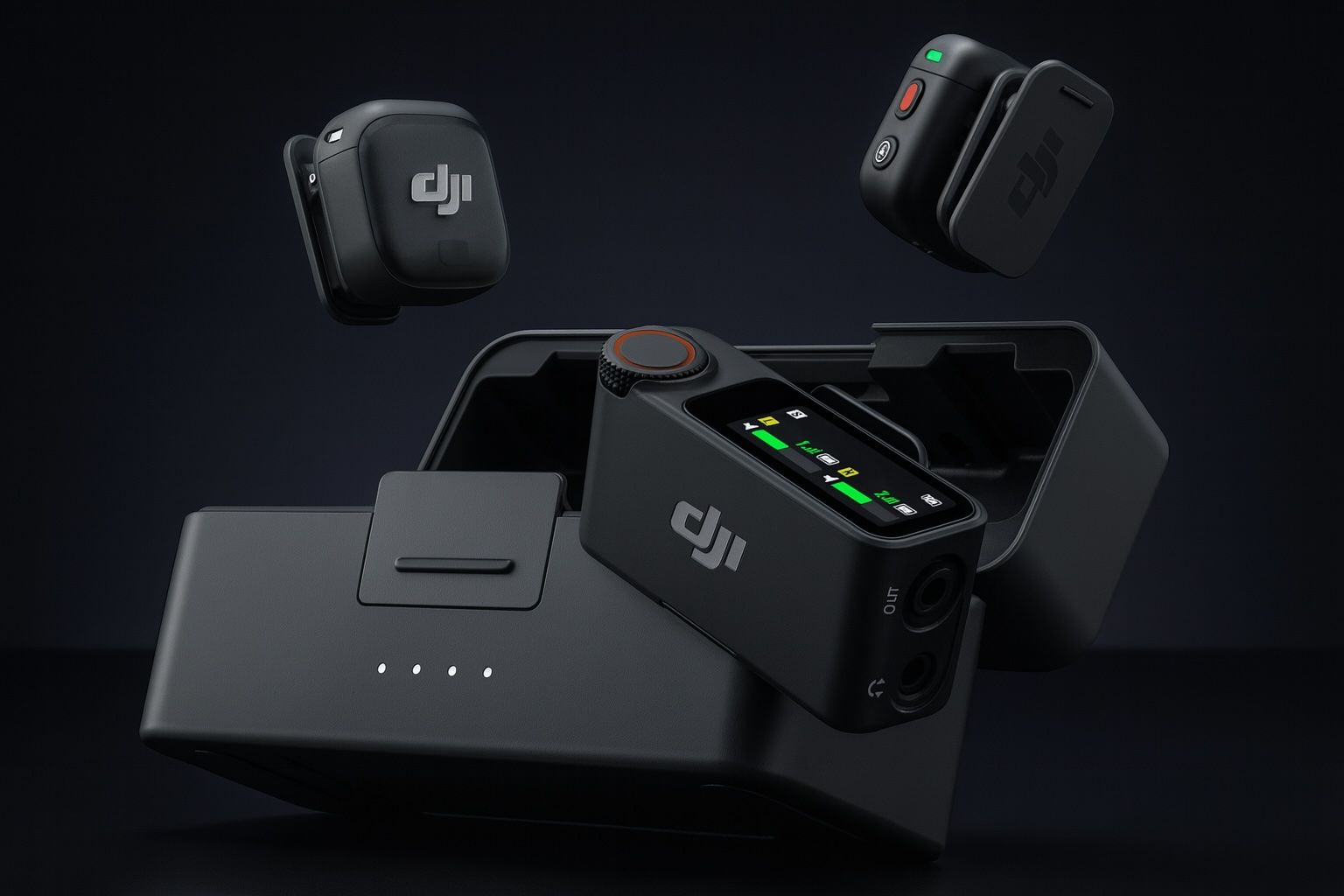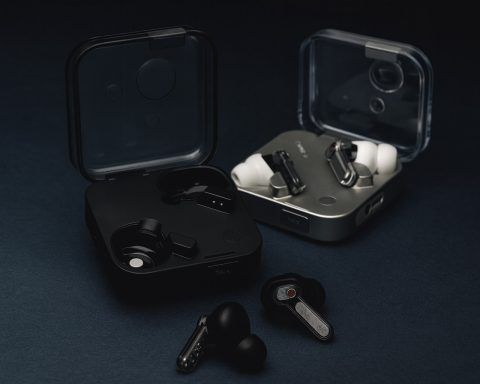Key Facts
- Launch & Overview: DJI officially unveiled the Mic 3 wireless lavalier microphone system on August 28, 2025. It’s roughly half the size and weight of the previous DJI Mic 2, yet it adds new capabilities like adaptive gain control, multiple voice presets, and expanded internal storage [1] [2]. The Mic 3 aims to deliver pro-grade audio in a miniaturized package.
- Multi-Mic Mastery: The DJI Mic 3 supports up to 4 transmitters and 8 receivers simultaneously – a first for DJI’s mic series – enabling multi-camera and group recordings with one system [3] [4]. A single receiver can handle four mics at once, and up to eight receivers can receive those signals, streamlining complex shoots.
- Pro Audio Features: New features include Adaptive Gain Control (Automatic and Dynamic modes) to prevent clipping or balance levels, three Voice Tone presets (Regular, Rich, Bright) to tune vocal tone, and two-level Active Noise Canceling to reduce background noise [5] [6]. Critically, it’s DJI’s first mic with 32-bit float dual-track internal recording and expanded 32 GB onboard storage, ensuring a huge dynamic range and backup audio with no clipping [7] [8].
- Battery & Range: Each Mic 3 transmitter runs up to ~8 hours and the receiver up to ~10 hours per charge [9]. The included charging case holds both mics and the receiver, providing ~2.4 extra charges (about 28 hours additional runtime) for all-day use [10]. DJI claims a robust wireless range up to 400 m (1,312 ft) thanks to automatic frequency hopping in the 2.4 GHz and 5 GHz bands for a rock-solid connection [11].
- Pricing & Availability: The DJI Mic 3 is available to order now via DJI and partners. It comes in a dual-mic kit at £259 / €309 (approx. $309 USD for 2 transmitters + 1 receiver + case) [12] [13]. A single-mic kit is offered at £169 / €199. Notably, DJI is also selling individual add-ons – e.g. an extra transmitter for ~$99 – allowing users to expand to a 3rd or 4th mic easily [14] [15]. The Mic 3 is already shipping in Europe and, unlike some recent DJI gear, is in stock in the US from launch day [16]. (It will debut publicly at the IFA tech expo in Berlin, Sept 5–9, 2025 [17].)
DJI Mic 3 Overview – Tiny Wireless Mic, Big Upgrades
DJI has carved a niche in creator gear by translating professional-quality tech into user-friendly, portable products. The Mic 3 continues that trend, offering “an ultralight wireless microphone” that DJI promises delivers “powerful performance and unmatched versatility” [18]. At just 16 g per transmitter, the Mic 3 is incredibly small – closer to the petite DJI Mic Mini (10 g) than the Mic 2 – yet it retains key pro features like on-board recording and a receiver touchscreen that the Mic Mini lacked [19]. In other words, it marries the portability of the Mini with the advanced capabilities of the Mic 2, and then some.
Core features & specs at a glance: The Mic 3 system includes two clip-on transmitters (with built-in mics) and one camera-mount receiver, plus a charging carry case. Each transmitter can record audio internally (24-bit or 32-bit float) to its 32 GB memory, providing a safety backup track in case wireless signal drops [20]. The transmitters attach via a removable rotating clip or magnets, and DJI even offers colored wind muffs (windscreens) in five colors to help them blend with clothing or scenery [21]. The receiver features a color touchscreen and a handy rotary dial for quick control, making it easy to adjust settings and monitor levels in real time [22].
Notably, DJI’s adaptive gain control is a highlight: it offers two modes to automatically manage audio levels. In Automatic mode, the system suppresses sudden loud spikes to avoid clipping (great for unpredictable outdoor events or loud environments). In Dynamic mode, it continuously adjusts gain to maintain consistent volume in quieter settings like studios [23]. This feature is designed to keep audio levels optimal on the fly, sparing creators the hassle of constant manual gain tweaks. Additionally, the three voice tone presets – Regular, Rich, Bright – let users tweak the character of voices (e.g. adding fullness or clarity) at the device level [24]. Paired with a two-level noise cancelation toggle (to cut steady background noises like A/C hum) and optional furry windscreens for wind noise, the Mic 3 aims to capture clean, broadcast-quality audio in varied conditions [25].
Wireless performance: DJI has upgraded the wireless link by enabling dual-band transmission – the Mic 3 can hop between 2.4 GHz and 5 GHz frequencies automatically to dodge interference [26]. This is intended to improve signal reliability in congested RF environments. The quoted maximum range is an impressive 400 m line-of-sight [27] (with footnotes likely assuming ideal conditions). That’s substantially farther than most 2.4 GHz-only systems. For example, RØDE’s Wireless Pro advertises ~260 m range in optimal settings [28] [29]. In practice, such range is overkill for most vloggers, but it speaks to signal robustness – at typical working distances (say 10–50 m), users can expect a stable connection without dropouts. DJI also touts “Dual-Channel Anti-Interference” and 128-bit encryption on the link for a secure, steady feed [30]. This stability is crucial for professional shoots; as DroneDJ notes, “stable transmission up to 400 meters” helps ensure you won’t lose audio even in challenging scenarios [31].
Audio fidelity and recording: The inclusion of 32-bit float recording is a game-changer for a compact wireless system. This technology captures an extremely wide dynamic range, effectively preventing audio from distorting if it gets too loud and preserving detail in very quiet sounds [32]. As The Verge reported, DJI has massively expanded the internal storage from 8 GB in the Mic 2 to 32 GB in the Mic 3 to accommodate these high-quality recordings [33]. Each transmitter can act as a standalone recorder, saving dual files (both the raw original and an “enhanced” track with DJI’s processing) – meaning even if wireless signal drops or a camera fails, your audio remains safely captured on the mic [34]. The recordings can be done in standard 24-bit or pristine 32-bit float; the latter allows rescuing virtually any clipping or underexposed audio in post. “Internal recording protects material from wireless interference or device issues, ensuring users never need to worry about lost audio,” DJI emphasizes [35]. For filmmakers, the Mic 3 also introduces timecode support: the transmitters can embed timecode data into recordings and keep it accurate within a frame over 24 hours [36]. This is a boon for multi-camera shoots, as it makes synchronizing audio to video much easier in post-production – a feature previously seen only on high-end professional audio kits.
Battery life & case: Despite the tiny size, battery life gets a boost. The transmitters run up to about 8 hours, and the receiver up to 10 hours on a charge [37] (a reversal of the Mic 2’s ~6 hour transmitter/receiver endurance [38]). The charging case – a staple of DJI’s mic kits – holds and recharges all units. DJI says the case can fully top up the system about 2.4 times, yielding ~28 hours of extra use before you need to find a power outlet [39]. Conveniently, a quick 5-minute charge in the case can provide ~2 hours of recording time [40], useful if you need to grab and go. The case itself is compact and designed to accommodate the mics without removing accessories – you can dock the transmitters with their windscreen and magnet still attached [41]. Creators who are used to fiddling with multiple charging cables will appreciate this all-in-one solution (RØDE’s Wireless Pro introduced a similar charging case concept, though it adds a bit more bulk [42] [43]).
Device connectivity: The Mic 3’s receiver outputs audio via a locking 3.5 mm TRS jack (for cameras or recorders) and also has a 3.5 mm TRRS port for live monitoring with headphones [44]. It charges or connects to a PC via USB-C. Impressively, DJI built direct smartphone connectivity into the system: you can pair a transmitter to a phone over Bluetooth as an external mic, without using the receiver module [45]. And for owners of DJI’s camera gear, the Mic 3 integrates seamlessly – DJI’s Osmo series cameras (Osmo 360, Action 5 Pro, Action 4, Pocket 3) can interface with Mic 3 wirelessly, piping audio straight in with no receiver needed [46]. This ecosystem integration minimizes the gear a creator has to mount or carry when using DJI cameras. It’s clear DJI envisions the Mic 3 as part of a broader toolkit alongside their drones, gimbals, and action cams.
In sum, DJI Mic 3’s spec sheet reads like a wish-list for content creators: a tiny, featherweight mic system brimming with pro-level features – from multi-mic networking and advanced audio processing to fail-safe recording and long battery life. As DJI’s press announcement put it, Mic 3 “enable[s] dynamic, high-quality sound” and gives creators “unprecedented level of control and creativity” in an ultralight form factor [47].
Launch News and Expert Commentary
The DJI Mic 3’s debut made waves in both the creator community and tech press. DJI first teased the product with the tagline “Performance That Speaks” ahead of the launch, hinting at a powerful audio tool [48]. On August 28, 2025, the official announcement dropped at 8 a.m. EDT, coinciding with detailed coverage on sites like The Verge and DroneDJ. The Verge highlighted how DJI managed to shrink the mic system “without scrimping on features or battery life” [49] – a notable engineering feat. Early hands-on impressions noted the Mic 3 feels like a direct response to user feedback on earlier models: for example, creators who loved the super-compact Mic Mini but missed having a screen and internal recording now have the Mic 3 as an ideal alternative [50].
One piece of initial uncertainty was the pricing and U.S. availability. The Verge’s report, published just as Mic 3 was announced, noted that DJI hadn’t immediately revealed the U.S. price and that the Mic 3 “won’t be available in the US immediately” at launch [51]. This suggested a staggered regional rollout – indeed DJI listed prices in GBP/EUR first, indicating a Europe-first release [52]. However, within hours the picture clarified: DroneDJ reported that Mic 3 units were already in stock at U.S. retailers on launch day [53]. In fact, DroneDJ’s Ishveena Singh called it “good news” that, unlike some recent DJI products, the Mic 3 was not held back from the U.S. market [54]. The base kit price in the U.S. is around $309 (for the dual mic kit), aligning with the ~€309 European price [55]. DJI’s decision to also offer a lower-cost expansion path – selling single transmitters for ~$99 – was widely noted, as it allows budget-conscious users to start with one mic and add more as needed [56]. Android Authority pointed out that DJI hasn’t shied away from higher price tags for its recent gadgets (like drones or even a robot vacuum), but with Mic 3 the focus is back on its core creator gear at a competitive price point [57].
Tech writers have praised several aspects of the Mic 3. Many were excited about the multi-mic capabilities. As Android Authority summarized, “the DJI Mic 3 now supports setups with up to four transmitters and eight receivers for cohesive multi-cam audio” [58] – a feature practically unheard of in consumer-friendly wireless mics until now. This makes the Mic 3 especially attractive for productions like panel interviews, on-location podcasting with multiple hosts, or event videography where multiple speakers need individual mics. Expert commentary has also focused on the audio advancements: SoundGuys and others lauded the addition of 32-bit float recording (which “allows you to control gain in post-production” with no quality loss) and the adaptive gain feature for “cleaner recordings” straight out of the device [59]. The consensus is that DJI is pushing features previously reserved for high-end professional audio gear down into a pocket-sized system.
Importantly, early reviews indicate DJI delivered on its promises. In a detailed review, AVForums (a respected home AV publication) gave the Mic 3 a glowing evaluation, even awarding it a score of 9/10 and a “Highly Recommended” badge [60] [61]. Reviewer Phil Hinton, an industry veteran, was struck by how the Mic 3’s audio quality held up against much larger pro systems: “Having used numerous traditional professional radio mic systems for the past two decades, I find the audio quality of these new mics to be remarkably good, virtually indistinguishable from my reliable old equipment,” Hinton wrote [62]. He noted that by integrating 32-bit float and timecode in such a compact design, DJI has placed the Mic 3 at the forefront of what’s achievable in this class [63]. In fact, he stated the Mic 3 will become the primary mic kit for AVForums’ own video productions going forward, for both on-location and studio work [64]. That is high praise, essentially endorsing it as a pro-grade tool.
Reviewers have found a few minor downsides. One point mentioned by AVForums and some users is that DJI removed the external lavalier input jack that was present on the original Mic and Mic 2 transmitters [65]. This means you cannot plug an external lapel microphone into the Mic 3’s transmitters – you must use the built-in mic on the clip. For many solo creators this is a non-issue (the built-in mics are high quality), but for filmmakers who sometimes want to hide a tiny lav mic on talent while concealing the bodypack, it reduces flexibility. “No LAV mic input… is unfortunate, as it proved beneficial in specific scenarios,” the AVForums review noted [66]. Another critique was that the “Strong” noise reduction setting can introduce a bit of distortion or digital artifacting in the audio [67]. In other words, while the two-level noise canceling is useful, using the highest level may affect audio fidelity slightly – something to use judiciously (and a common trade-off in noise filters). Overall, though, early users report that the benefits heavily outweigh the niggles. The Mic 3’s build quality, intuitive interface, and rich feature set have drawn positive comparisons to its competitors and predecessors.
It’s also worth noting the timing and context of this launch. DJI has been diversifying its product lines beyond drones – from handheld cameras to microphones – especially as its drone business faces regulatory headwinds in the U.S. (import bans and security scrutiny) [68] [69]. The Mic 3 arrives at a moment when DJI’s hardware availability in the U.S. is uncertain, but audio gear like this mic is providing a bright spot for creators who might worry about future DJI access [70]. As DroneDJ observed, “Mic 3 strikes at a fortuitous moment: when access to DJI hardware is uncertain, this US-available audio tool offers a lifeline for creators, educators, and professionals” [71]. In other words, even if drones become harder to get, DJI’s move into creator accessories like microphones ensures the brand stays relevant and accessible to its user base. That strategic context wasn’t lost on industry watchers: the Mic 3’s strong launch suggests DJI is committed to the content creator market for the long haul.
How DJI Mic 3 Stacks Up Against Competitors
The wireless microphone arena in late 2025 is highly competitive, with several brands vying for the attention of vloggers, videographers, and filmmakers. The DJI Mic 3 enters as an aggressively equipped contender. Here we compare it to a few top competitors and alternatives:
DJI Mic 3 vs. RØDE Wireless Pro
Australian audio giant RØDE is a key player, and their Wireless Pro (launched 2023) has been one of the gold standards for compact wireless mics. Priced around $399 for a dual-transmitter kit, the Wireless Pro introduced many pro features that DJI is now matching – and even exceeding in some areas [72]. Common strengths: Both systems offer 32-bit float on-board recording (with roughly 32 GB internal memory per transmitter on each) for essentially foolproof audio capture [73] [74]. They also both feature timecode sync capability, which was a standout feature of the Wireless Pro and is now in the Mic 3 [75] [76]. This means either system can be used in multi-camera shoots and the audio will sync up exactly with video that’s timecoded – a big deal for professional post-production. Additionally, each has some form of auto gain: RØDE calls theirs GainAssist, DJI calls it Adaptive Gain [77] [78]. These are different implementations but serve a similar purpose of managing levels automatically to prevent clipping or overly quiet audio.
What sets them apart? One major difference is capacity: the RØDE Wireless Pro is a 2-channel system (two mics to one receiver max), whereas DJI Mic 3 can scale up to 4 mics on one receiver. RØDE currently doesn’t offer any single system that can handle more than two transmitters at once, so DJI has an edge for users needing 3-4 microphones in sync. Another contrast is range and transmission. RØDE uses a proprietary Series IV 2.4 GHz digital transmission with claimed range up to ~260 m (850 ft) line-of-sight [79] [80]. DJI’s dual-band system extends that to 400 m in theory [81]. In real use, both provide ample range for typical filmmaking scenarios, but DJI’s use of the 5 GHz band might give it more resilience in extremely RF-dense environments. RØDE’s Wireless Pro transmitters have around 7 hours battery life each [82] [83], slightly less than DJI’s 8–10 hours, and its charging case adds ~14 hours of extra charge [84] (half of DJI’s 28-hour reserve). One advantage for RØDE is that it includes two Lavaliere microphones in the kit – high-quality Lavalier II mics worth $99 each [85] [86]. The Wireless Pro transmitters have 3.5 mm inputs so you can use those external lav mics (or any other lav of your choice) instead of the built-in mic capsules. As mentioned, the DJI Mic 3 has no external mic jack, so you must use its built-in mics. For users who want the smallest visible mic (just a lav head) on talent, RØDE’s approach might be preferable. On the other hand, DJI’s touchscreen receiver interface is arguably more modern and user-friendly than RØDE’s small monochrome display – making on-device control easier on the Mic 3. Both systems offer analog and digital outputs (RØDE’s receiver can output via 3.5 mm or USB-C; DJI similarly can do analog out or direct USB digital/Bluetooth to devices).
Bottom line: The RØDE Wireless Pro remains a powerhouse (with reviewers calling it “very competitively priced” given all the accessories and features included [87] [88]). But DJI has undercut it on price and leapfrogged in expandability. Creators already invested in RØDE gear or who value lavalier mics may stick with the Wireless Pro for its rock-solid performance and ecosystem (e.g. integration with the RØDECaster mixers). Meanwhile, those who need a more scalable solution or a slicker interface will find DJI Mic 3 extremely compelling. Both deliver superb audio quality – truly, two top-tier options that push wireless audio into “zero compromise” territory for under $400.
DJI Mic 3 vs. Hollyland Lark Max
Hollyland has emerged as a strong competitor in the wireless mic segment, known for slightly more affordable yet feature-rich systems. The Hollyland Lark Max (introduced in 2023) was explicitly aimed at competing with the DJI Mic series “at an even more affordable price”, according to CineD’s review [89]. Indeed, the Lark Max launched at $299 for a duo (2TX+RX) kit and ~$199 for a solo kit [90] – very similar to DJI’s pricing. Hollyland’s kit also included a charging case and both internal and external mic options.
One advantage of Lark Max (gen 1) was that each transmitter had a 3.5 mm input for external lavaliers, and the package actually came with external lav mics. Reviewers noted this feature as essential – “if this feature was not available, I’d skip the device altogether,” one reviewer wrote, underscoring how important the lav input is for many users [91]. Thus, Hollyland provided flexibility to either clip the transmitter directly or use a wired lav for a more discreet mic. DJI’s Mic 3, by contrast, forgoes that input to save size. Audio quality on the Lark Max was praised as “rich, lifelike, and very pleasant,” showing Hollyland’s mic capsules and processing are no slouch [92]. The Lark Max also offered on-board recording, albeit in standard 24-bit format (with about 8 GB internal memory per transmitter) [93] [94]. Before 32-bit float became common, Hollyland implemented a “safety track” feature: the transmitter could output a duplicate track at -6 dB lower level to the camera, to protect against clipping [95]. However, it couldn’t record a dual safety track internally at the time [96]. Now that DJI and RØDE have gone the 32-bit route, Hollyland has responded with the Lark Max 2 (announced mid-2025) which is expected to add 32-bit float recording and other upgrades [97] [98]. The Lark Max 2 is reportedly going to support 32-bit float internal recording and advanced wireless features, keeping Hollyland in the race with DJI’s latest.
In terms of wireless tech, the Lark Max uses the 2.4 GHz band with frequency hopping and had a range rated around 200–250 m in ideal conditions [99]. It also featured ENC (Environmental Noise Cancellation) processing – similar in concept to DJI’s noise canceling – to reduce ambient sounds like AC or wind. The CineD review found Hollyland’s ENC effective for steady background noise, though it could struggle with very loud environments (a common limitation of such algorithms) [100] [101]. The battery life of Lark Max was solid: each transmitter ran for many hours (comparable to DJI’s older models), and the case provided additional charges. One note: Lark Max had 8 GB storage vs. DJI Mic 3’s 32 GB, meaning DJI can hold much more audio data (useful for 32-bit files).
In summary: The Hollyland Lark Max duo offers a similar value proposition in a two-mic system – great sound, internal recording backup, and a slightly lower entry price. For those who prioritize using external lav mics, Hollyland might have the edge over DJI’s built-in-only approach. However, Mic 3 leapfrogs ahead with 32-bit float audio and multi-mic scalability up to 4 channels, which Hollyland’s first-gen system can’t do. With Lark Max 2 on the horizon bringing 32-bit float, the competition will heat up further. It’s a win for consumers: Hollyland, DJI, and others are effectively in a features arms race, driving innovation. As one reviewer put it, once you’ve experienced internal recording and advanced features, “there is no going back” – these conveniences are becoming standard [102]. DJI Mic 3 currently stands at the cutting edge, but Hollyland is close behind, typically at a budget-friendly price point.
DJI Mic 3 vs. Sennheiser EW-DP (Pro UHF Systems)
For high-end users and broadcast professionals, Sennheiser’s EW-DP series represents the state-of-the-art in wireless audio – albeit in a very different class and price bracket. The EW-DP (Evolution Wireless Digital – Portable) is a fully digital UHF wireless system Sennheiser launched in 2023, aimed at filmmakers and ENG (electronic news gathering) applications. A basic camera-mount EW-DP kit (transmitter and receiver) retails around $699–899 depending on configuration [103] [104], which is roughly 2–3 times the cost of a DJI Mic 3 kit. In return, it offers features like licensed-frequency UHF transmission (which can be more reliable than crowded 2.4 GHz in certain scenarios), 134 dB of dynamic range on the audio (essentially no audible noise floor) [105], extremely low latency (~1.9 ms), and industry-standard interoperability (swappable transmitters: handheld mics, bodypacks, plug-on units, etc. that can all work with the receiver) [106] [107]. The EW-DP receiver is a small box with a bright OLED display and a unique magnetically stackable design (multiple receivers can snap together for multi-channel setups) [108]. It integrates with a mobile app for configuration and monitoring.
Comparing DJI Mic 3 to Sennheiser EW-DP is a bit of apples vs oranges – one is a consumer/prosumer 2.4/5 GHz device, the other a professional UHF system. However, it’s telling how far products like DJI’s have come. The Mic 3 actually incorporates some features the Sennheiser lacks out of the box: notably, 32-bit float internal recording (most EW-DP transmitters do not record internally, though Sennheiser offers a plug-on transmitter model with an onboard recorder as a separate component [109] [110]). Also, setting up a four-microphone rig with EW-DP would require four separate receivers (one per channel) or at least two dual-channel receivers – an expensive and bulky proposition. DJI can handle four mics with one receiver, albeit with some trade-offs in robustness.
In pure performance, Sennheiser’s digital wireless boasts bulletproof reliability in challenging RF environments where a 2.4 GHz system might struggle. It operates in dedicated frequency bands (e.g. 500–600 MHz range, depending on region) with high transmission power, making it suitable for big productions, live events, and places with heavy wireless traffic. Its audio quality is top-notch; users report pristine sound and virtually no dropouts when properly set up. That said, smaller systems like DJI’s have surprised experts: in one test, Fstoppers found that Sennheiser’s new EW-DP “should easily be able to outperform DJI’s wireless lav mics… but that didn’t happen” – the DJI mics worked flawlessly throughout, while the Sennheiser kit experienced a dropout in the same test [111]. This anecdote illustrates that for many real-world uses, a modern 2.4 GHz system can hold its own. Unless you are regularly shooting in extremely interference-prone venues or require dozens of wireless channels at once, the convenience of something like the Mic 3 may outweigh the theoretical advantages of a UHF system.
Cost and complexity are also factors: a single DJI Mic 3 dual-mic kit (~$300) provides a turn-key two-mic solution with recorder, whereas a Sennheiser EW-DP two-mic setup might easily run $1500+ and still require external audio recorders (if you need backups). For independent creators, wedding filmmakers, or small crews, the DJI offers 80–90% of the capability at a fraction of the cost and setup time. Sennheiser (along with brands like Sony, Shure, and Lectrosonics) will remain the choice for large productions and broadcast networks that demand absolute reliability and where budget is less a concern. But it’s telling that the gap has significantly closed. The DJI Mic 3, RØDE Wireless Pro, and similar devices are bringing features like 32-bit float and digital clarity that were once exclusive to pro gear, down to mainstream users.
Other Alternatives
Aside from the big names above, the market has many other wireless mic solutions. Systems like the RØDE Wireless ME (a simpler, more budget-friendly sibling of the Wireless Pro) target casual users with an even lower price and very easy setup – but they sacrifice features like internal recording and multiple channels. Deity Microphones (by Aputure) have their Deity Theos digital wireless, which also introduced timecode and 32-bit float recording (it’s more directly aimed at competing with Sennheiser in the prosumer range). Saramonic, Boya, Comica, and others offer various 2.4 GHz mic kits at lower price points, though generally with fewer features. For example, Saramonic’s Blink series or new Saramonic Blink Me and BoyaLink systems include things like touchscreens or app control, but not the full suite of capabilities DJI now offers [112] [113]. In short, DJI Mic 3 has positioned itself at the high end of the compact wireless mic segment, where it competes mostly with the Rode and Hollyland offerings discussed. Cheaper systems exist for those on a tight budget, but they typically lack the safety nets (no internal recording, less range, etc.) that professionals and serious creators demand. Mic 3 fills a niche for creators who need reliability and pro features without stepping up to bulky traditional setups.
Target Users: Who Should Use the DJI Mic 3?
The DJI Mic 3 is squarely aimed at content creators and videographers of all stripes – anyone who needs high-quality wireless audio in a convenient package. Here are some of the user groups and scenarios where Mic 3 shines:
- YouTubers & Solo Vloggers: For on-camera personalities who film themselves, good audio is as important as video. The Mic 3’s compact transmitters can clip on discreetly (or attach via magnet under clothing) to capture clear voice audio while the creator moves freely. Its adaptive gain means if you suddenly speak louder or softer, the levels adjust on the fly – useful for dynamic, run-and-gun vlogging [114]. Vloggers will also appreciate the direct smartphone connectivity: you can use a Mic 3 transmitter to record into your phone when doing mobile live streams or TikToks, no wires or bulky adapters needed [115]. And with the charging case, a solo creator can travel all day without worrying about batteries (28 hours of backup covers a lot of shooting) [116].
- Interviewers & Podcasters: The ability to handle multiple mics makes the Mic 3 ideal for two-person or multi-person interviews. For example, a journalist can mic up three interviewees plus themselves with one Mic 3 system (adding two extra transmitters sold separately) and record all voices in sync. The Quadraphonic mode DJI mentions even allows outputting four separate audio tracks if paired with certain devices or software [117]. This is perfect for panel discussions or on-location podcasts – each person’s audio can be isolated for mixing. The noise canceling can help in busy environments (trimming out background chatter or AC noise), and the tone presets can be used to ensure each person’s voice is captured clearly (e.g. using “Bright” for someone with a very low, muffled voice) [118]. For podcasting on the go, the Mic 3 essentially serves as a tiny multi-channel wireless studio.
- Filmmakers & Videographers: Indie filmmakers and wedding videographers often operate with small crews (or solo). The Mic 3 caters to them by removing hurdles in audio. Its timecode sync is a huge plus for multi-camera shoots – for example, if you’re filming a scene with two camera angles, the Mic 3’s timecoded audio will sync precisely with both camera feeds in post, saving time [119]. The range and interference resistance means that even if a subject walks a good distance away (say you’re shooting a bride and groom with a long lens), their mic stays connected [120]. With four mic capability, a filmmaker can mic up four actors in a scene and capture all their dialogue wirelessly to one receiver – something previously requiring much bulkier field audio mixers or multiple kits. The internal 32-bit float recording provides a safety net for critical moments: if an actor suddenly shouts a line that’s louder than expected, the on-board file won’t clip even if the wireless feed did. Essentially, Mic 3 gives budget filmmakers some of the same tools used in Hollywood sound recording, but in an easier form. As AVForums noted, the audio quality is “high enough for all but the most high-end productions”, meaning it suffices for professional projects outside of maybe big-budget films [121]. Many videographers (wedding, corporate, documentary) will likely adopt Mic 3 as a primary audio kit for its balance of quality and convenience.
- Educators, Speakers, and Live Streamers: With its ease of use, the Mic 3 is also great in classrooms, live online presentations, or conference settings. A teacher or presenter can wear one mic, pass another to a guest or student, etc., and feed the audio either into a camera, a computer (via USB-C), or even a PA system. The real-time monitoring on the receiver and headphone jack allows an assistant to keep an ear on the sound quality during a live event. Moreover, DJI’s multi-platform compatibility (cameras, phones, computers) means it’s a versatile tool for those who need to record or stream on different devices. A church or community theater, for instance, could use a couple of Mic 3 sets to mic up multiple performers on stage and record the audio or send it to speakers, leveraging the long range to cover the whole venue.
In summary, the target user is anyone who values high-quality audio capture without a complicated setup. DJI explicitly calls out content creators, vloggers, and multi-cam shooters as key beneficiaries [122]. The Mic 3’s feature set indeed reads like a checklist for modern creators: portable, quick to deploy, able to handle anything from a single talking head to a roundtable interview. Even professionals with access to high-end gear might choose Mic 3 for simpler jobs or as a backup system because it’s so light and capable. And for those just starting to elevate their video production, the Mic 3 could be the one audio kit that “does it all” and grows with their needs.
Market Implications and Trends
The launch of DJI Mic 3 underscores several broader trends in the audio-tech and creator market:
- Convergence of Pro and Consumer Tech: The Mic 3 exemplifies how features once exclusive to professional audio are filtering down to mainstream creator devices. A few years ago, 32-bit float recording and timecode sync in a wireless mic would have been unthinkable outside of $1000+ gear. Now DJI and RØDE are offering these in sub-$400 kits [123] [124]. This trend is blurring the lines between “prosumer” and true professional equipment. Content creators on YouTube or freelance videographers can achieve near-broadcast quality sound without renting expensive kits or hiring dedicated sound recordists, which democratizes video production further. As one reviewer put it, it’s “impressive that a sound recording system with 32-bit float and timecode can be had for under $400” [125] [126]. We can expect future products from all players in this segment to continue this trajectory – more pro features, same compact form.
- Multi-Source Content Creation: The emphasis on handling multiple microphones speaks to a trend of more complex content creation setups. It’s not just a solo vlogger speaking to camera anymore; creators are doing podcasts, collab videos, multi-person vlogs, etc. DJI clearly sees a demand for easy multi-mic workflows – something competitors will likely respond to. We might see RØDE or others explore linking two dual-mic systems together, or releasing their own 3-4 channel systems, to catch up with this feature of the Mic 3. In the broader market, even smartphone audio accessories are starting to allow two or more wireless mics for interviews on the go. The Mic 3 is at the forefront, effectively turning one receiver into a mini audio mixer for four sources.
- Reliability and Backup are King: Another trend underscored is the prioritization of fail-safe audio. With internal recording and dual-channel signals, devices like Mic 3 and Wireless Pro acknowledge that creators don’t want to risk losing audio – ever. The horror of filming a one-time event and discovering audio dropouts or clipping has driven these brands to build redundancy (safety tracks, backups) into their products. This trend likely comes from user feedback and the high stakes of live or one-chance content (weddings, live streams, etc.). We can expect new entrants to incorporate similar safety features – for instance, Hollyland’s upcoming models adding 32-bit float to eliminate the need for separate safety tracks [127] [128]. Ultimately, this is great for creators: the technology is compensating more for human error or unforeseen issues, letting them focus on creative aspects.
- DJI’s Expansion into Creator Tools: On the company level, the Mic 3’s launch highlights DJI’s successful expansion beyond drones into the wider creator economy. Over the past few years DJI has rolled out products like the Osmo Pocket cameras, gimbals like Ronin/RS series, action cams, and mics – building an ecosystem that positions DJI almost like a one-stop shop for content creators. The Mic 3 integrating with DJI cameras (Osmo, Action) is a strategy to lock users into the DJI ecosystem for a seamless workflow [129]. It resembles how companies like Apple or GoPro operate, where hardware and software are tightly integrated. Market-wise, this puts pressure on traditional audio companies; DJI is leveraging its brand and distribution to grab market share in audio. Given DJI’s scale (as the dominant drone maker), its push into audio is significant – it brings more competition and likely accelerates innovation. For example, RØDE and Sennheiser now face a non-traditional rival that iterates fast (DJI has gone from Mic 1 to Mic 3 in just a couple of years). For consumers, more competition often means better value and feature-rich products as each company tries to outdo the other.
- Content Creation Boom Continues: The very existence of products like Mic 3 with such advanced features at moderate cost signals that the content creation boom (post-pandemic) is still in full swing. Companies are betting on a growing base of independent creators, remote workers, educators, and small businesses producing video content. High-quality audio used to be a pain point for newcomers; now it’s becoming plug-and-play. The industry trend is to remove technical barriers – good audio, stable footage (via gimbals), high-quality visuals (affordable 4K cameras, drones) – so that anyone can create professional-looking (and sounding) content. DJI’s Mic 3 is one piece of that puzzle, and its launch reinforces the notion that “creator tech” is a hot market. It’s likely we’ll see further integration across product categories: e.g., camera makers teaming up with audio tech (Sony has its digital mic interfaces, Canon and Nikon might partner or build their own wireless audio). The boundaries between camera, audio, and even lighting gear ecosystems may blur as manufacturers try to offer complete solutions.
- User Feedback Loop: Lastly, the Mic 3 shows that companies are listening to user feedback closely and iterating. The Mic 2 was well-regarded but had room for improvement (size, storage, etc.), and the Mic Mini was portable but too stripped-down for some. DJI effectively combined the best of both and added new ideas like 4-mic support. This rapid iteration cycle (launching new models or firmware updates yearly) is a trend in the tech industry responding to creators’ evolving needs. It means consumers can expect their gear to improve or be updated more frequently. However, it also challenges creators to decide when to upgrade. With Mic 3’s features leap, some Mic 1 or 2 owners might feel tempted to jump to the new model to get the latest capabilities. The pace of innovation might shorten product lifespans in this category (much like smartphones), a trend that has pros and cons for the market.
In essence, DJI Mic 3’s arrival signals a maturation of the wireless audio market for creators – one where high fidelity, multi-channel audio is accessible and where competition is driving feature parity with pro equipment. As more voices join the content creation space, having tools like the Mic 3 ensures those voices are heard loud and clear, without technical hurdles. Industry experts are optimistic: DJI’s new mic is seen not just as a product launch, but as a bar-raising moment. “Mic 3 is poised to be the most ambitious mic kit DJI has ever delivered — built for modern creators demanding flexibility, fidelity, and multi-channel control,” DroneDJ wrote in anticipation [130]. Now that it’s here, it indeed challenges the market to keep up, ultimately benefiting creators with better audio tech at lower costs.
Quotes from Experts and Official Sources
To round out this report, here are a few notable quotes about the DJI Mic 3 from industry experts and DJI itself:
- DJI (Press Release): “DJI Mic 3 [is] an ultralight wireless microphone offering powerful performance and unmatched versatility… supporting up to four transmitters and eight receivers, making multi‑camera production and group recordings effortless.” [131] (DJI’s launch announcement emphasizing the system’s versatility for complex shoots.)
- The Verge (Tech News): “DJI is making its latest wireless lavalier microphone system even smaller without scrimping on features or battery life. The DJI Mic 3 is half the size and weight of its Mic 2 predecessor and introduces new capabilities, including two adaptive gain control modes, three voice tone presets, and a sizable increase in storage capacity for internal recordings.” [132] (Jess Weatherbed, The Verge, highlighting how the Mic 3 achieves a rare combo of miniaturization and feature expansion.)
- DroneDJ (Analysis): “The system looks tailor-made for content creators, vloggers, and anyone needing pristine, multi-source sound with unparalleled flexibility.” [133] (DroneDJ’s take on who the Mic 3 is built for, noting its flexibility with multi-mic setups.)
- AVForums (Review): “The integration of professional features such as 32-bit float and timecode places [the Mic 3] at the forefront of what’s achievable in such a compact design. Consequently, the DJI Mic 3 will become the primary microphone system for the majority of our video productions, both on location and in the studio.” [134] (Phil Hinton, AVForums editor, praising the Mic 3’s pro-grade features and signaling he’ll be using it extensively in real-world production – a strong endorsement of its quality.)
- Newsshooter (Competitor Context): “RØDE… built [the Wireless Pro] with a lot of new features, including longer-range and 32-bit float internal recording… Another great feature is LTC timecode… The third big feature is the price. It retails for $399. I feel you get a lot for this price.” [135] (Erik Naso, Newsshooter, on RØDE’s Wireless Pro. This sets the stage for DJI Mic 3’s competition – coming in at a lower price with a similar feature set, arguably providing even more value in some areas.)
- CineD (Competitor Context): “The LARK MAX duo… [is] priced at $299, and the solo at $199. Looking at those prices, it seems as if they were designed to combat the popular DJI Mic, and at an even more affordable price.” [136] (CineD review noting Hollyland’s pricing strategy against DJI’s earlier mics. The Mic 3 now responds by upping features, indicating a competitive leapfrog between the brands.)
- Fstoppers (Pro vs Consumer Test): “Sennheiser’s new EW-DP lav mic system should easily be able to outperform DJI’s wireless lav mics… but that didn’t happen.” [137] (Fstoppers, via Clubsnap forum, hinting at a test where DJI’s mic system proved surprisingly robust, challenging assumptions that pricier traditional systems always win – a nod to how far these compact systems have come.)
These quotes collectively capture the excitement and key talking points around DJI Mic 3. From DJI’s own proclamation of versatility, to journalists marveling at its feature-to-size ratio, to experts affirming it in real use, the Mic 3 is making a strong impression. It’s portrayed as a breakthrough product that brings professional capabilities to everyday creators, which aligns with the broader narrative of tech empowering independent production.
External Links for Further Reference:
- DJI Mic 3 – Official Product Page: Learn more about specifications, package options, and official FAQs on DJI’s website [138].
- RØDE Wireless Pro – Product Info: For comparison, see RØDE’s page on the Wireless Pro, which details its 32-bit float recording, timecode, and accessory kit [139] [140].
- Hollyland Lark Max Review (CineD): In-depth review of Hollyland’s wireless mic, discussing features like ENC noise cancellation and internal recording, useful for understanding alternative approaches [141] [142].
- Sennheiser EW-DP Overview: Official info on Sennheiser’s EW-DP series, for those interested in high-end wireless systems (features digital UHF transmission, app integration, and modular components) [143] [144].
- DroneDJ Coverage of Mic 3: News and analysis pieces by DroneDJ provide additional context on DJI’s launch timing, US availability, and how it fits into DJI’s product lineup [145] [146].
With the DJI Mic 3, the wireless audio landscape has undeniably shifted. By packing cutting-edge tech into a pocket-sized device, DJI is not only challenging its competitors – it’s empowering creators to capture audio with a level of quality and confidence that was previously out of reach at this price point. In the words of DJI’s launch slogan, this mic delivers “Performance That Speaks” [147] – and it’s a message the industry is hearing loud and clear.
References
1. www.theverge.com, 2. www.mynewsdesk.com, 3. www.mynewsdesk.com, 4. dronedj.com, 5. www.mynewsdesk.com, 6. www.mynewsdesk.com, 7. www.mynewsdesk.com, 8. www.mynewsdesk.com, 9. www.mynewsdesk.com, 10. www.mynewsdesk.com, 11. www.mynewsdesk.com, 12. www.mynewsdesk.com, 13. dronedj.com, 14. dronedj.com, 15. dronedj.com, 16. dronedj.com, 17. www.mynewsdesk.com, 18. www.mynewsdesk.com, 19. www.theverge.com, 20. www.mynewsdesk.com, 21. www.mynewsdesk.com, 22. dronedj.com, 23. www.mynewsdesk.com, 24. www.mynewsdesk.com, 25. www.mynewsdesk.com, 26. www.mynewsdesk.com, 27. www.mynewsdesk.com, 28. www.newsshooter.com, 29. www.newsshooter.com, 30. dronedj.com, 31. dronedj.com, 32. www.avforums.com, 33. www.theverge.com, 34. www.mynewsdesk.com, 35. www.mynewsdesk.com, 36. www.mynewsdesk.com, 37. www.mynewsdesk.com, 38. www.theverge.com, 39. www.mynewsdesk.com, 40. www.mynewsdesk.com, 41. www.mynewsdesk.com, 42. appleinsider.com, 43. appleinsider.com, 44. www.mynewsdesk.com, 45. www.mynewsdesk.com, 46. www.mynewsdesk.com, 47. www.mynewsdesk.com, 48. dronedj.com, 49. www.theverge.com, 50. www.theverge.com, 51. www.theverge.com, 52. www.mynewsdesk.com, 53. dronedj.com, 54. dronedj.com, 55. dronedj.com, 56. dronedj.com, 57. www.androidauthority.com, 58. www.androidauthority.com, 59. www.androidauthority.com, 60. www.avforums.com, 61. www.avforums.com, 62. www.avforums.com, 63. www.avforums.com, 64. www.avforums.com, 65. www.avforums.com, 66. www.avforums.com, 67. www.avforums.com, 68. dronedj.com, 69. dronedj.com, 70. dronedj.com, 71. dronedj.com, 72. www.newsshooter.com, 73. www.newsshooter.com, 74. www.newsshooter.com, 75. www.newsshooter.com, 76. www.avforums.com, 77. www.newsshooter.com, 78. www.newsshooter.com, 79. www.newsshooter.com, 80. www.newsshooter.com, 81. www.mynewsdesk.com, 82. www.newsshooter.com, 83. www.newsshooter.com, 84. www.newsshooter.com, 85. www.newsshooter.com, 86. www.newsshooter.com, 87. www.newsshooter.com, 88. www.newsshooter.com, 89. www.cined.com, 90. www.cined.com, 91. www.cined.com, 92. www.cined.com, 93. www.cined.com, 94. www.cined.com, 95. www.cined.com, 96. www.cined.com, 97. www.cined.com, 98. www.markertek.com, 99. www.hollyland.com, 100. www.cined.com, 101. www.cined.com, 102. www.cined.com, 103. www.cined.com, 104. www.newsshooter.com, 105. www.bhphotovideo.com, 106. nofilmschool.com, 107. www.sennheiser.com, 108. www.sennheiser.com, 109. www.newsshooter.com, 110. www.bhphotovideo.com, 111. clubsnap.com, 112. clubsnap.com, 113. clubsnap.com, 114. www.mynewsdesk.com, 115. www.mynewsdesk.com, 116. www.mynewsdesk.com, 117. www.mynewsdesk.com, 118. www.mynewsdesk.com, 119. www.mynewsdesk.com, 120. dronedj.com, 121. www.avforums.com, 122. dronedj.com, 123. www.newsshooter.com, 124. www.avforums.com, 125. appleinsider.com, 126. appleinsider.com, 127. www.cined.com, 128. www.cined.com, 129. www.mynewsdesk.com, 130. dronedj.com, 131. www.mynewsdesk.com, 132. www.theverge.com, 133. dronedj.com, 134. www.avforums.com, 135. www.newsshooter.com, 136. www.cined.com, 137. clubsnap.com, 138. www.mynewsdesk.com, 139. www.newsshooter.com, 140. www.newsshooter.com, 141. www.cined.com, 142. www.cined.com, 143. www.amazon.com, 144. www.sennheiser.com, 145. dronedj.com, 146. dronedj.com, 147. dronedj.com









